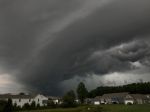The effort to place a massive containment dome over a gushing underwater wellhead in the Gulf of Mexico was dealt a setback when a large volume of hydrates — icelike crystals that form when gas combines with water — accumulated inside the vessel, a BP official said Saturday.
The dome was moved off to the side of the wellhead and is resting on the seabed while crews work to overcome the challenge, a process expected to take at least two days, BP’s chief operations officer Doug Suttles said.
Suttles declined to call it a failed operation but said “What we attempted to do last night didn’t work.”
Suttles said the gas hydrates are lighter than water and, as a result, made the dome buoyant. The crystals also blocked the top of the dome, which would prevent oil from being funneled up to a drill ship.
“We did anticipate hydrates being a problem, but not this significant [of one],” he said.
Also Saturday, response crews discovered tar balls on a beach on Dauphin Island, Alabama, and sent them to a lab to determine if they’re from the Gulf Coast oil slick.
The analysis could take 48 hours to complete, the Deepwater Horizon Incident Joint Information Center said Saturday.
The tar balls, which a U.S. Coast Guard spokesman described as “pieces of emulsified oil” shaped like pancakes, ranged in size from dimes to golf balls. Tar balls can sometimes occur naturally, said the spokesman, Erik Swanson.
Cleanup crews have placed snare boom — a pompom shaped material designed to collect tar balls — around Dauphin Island.
Read Full Story
Article courtesy cnn.com
















